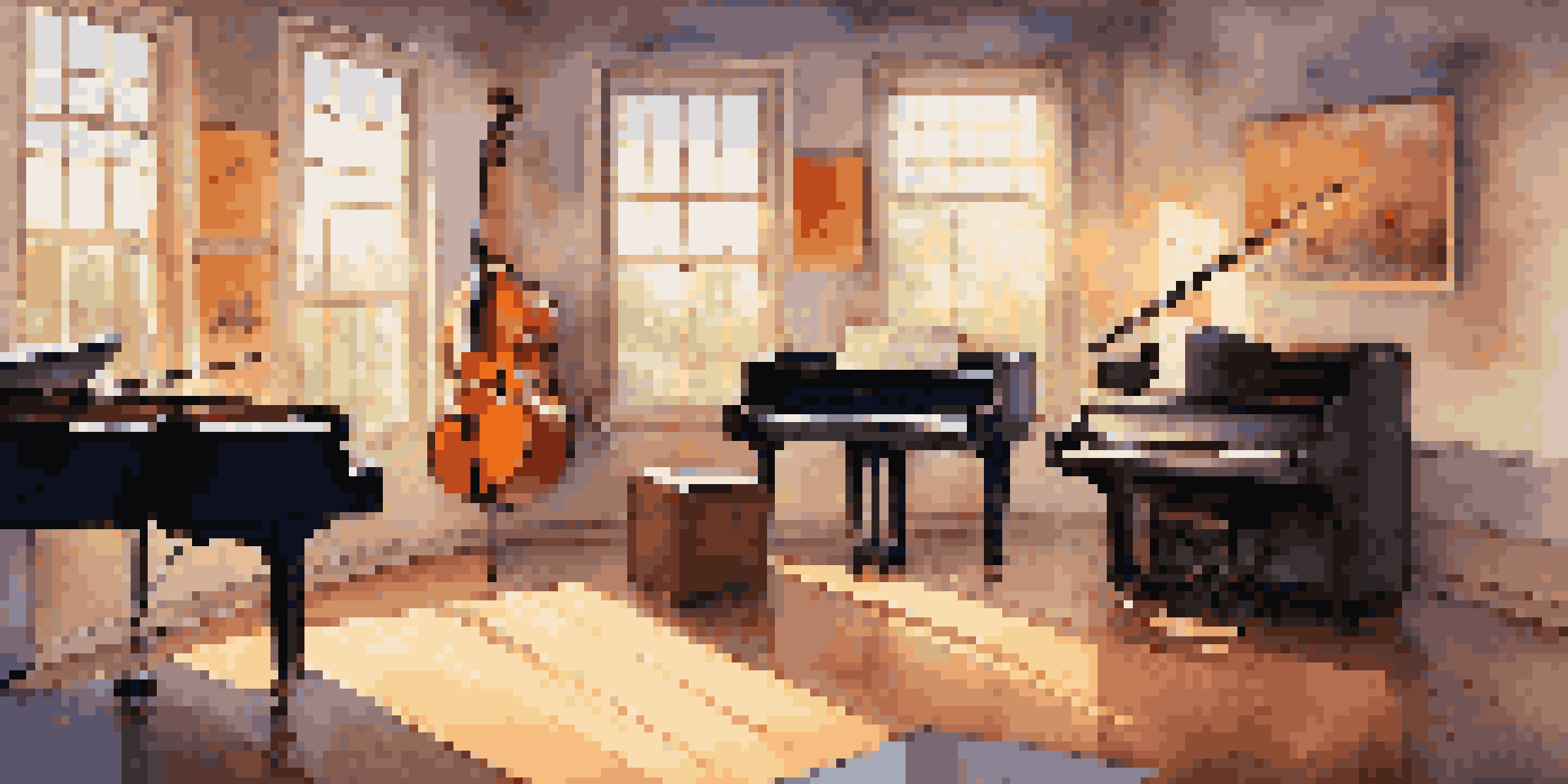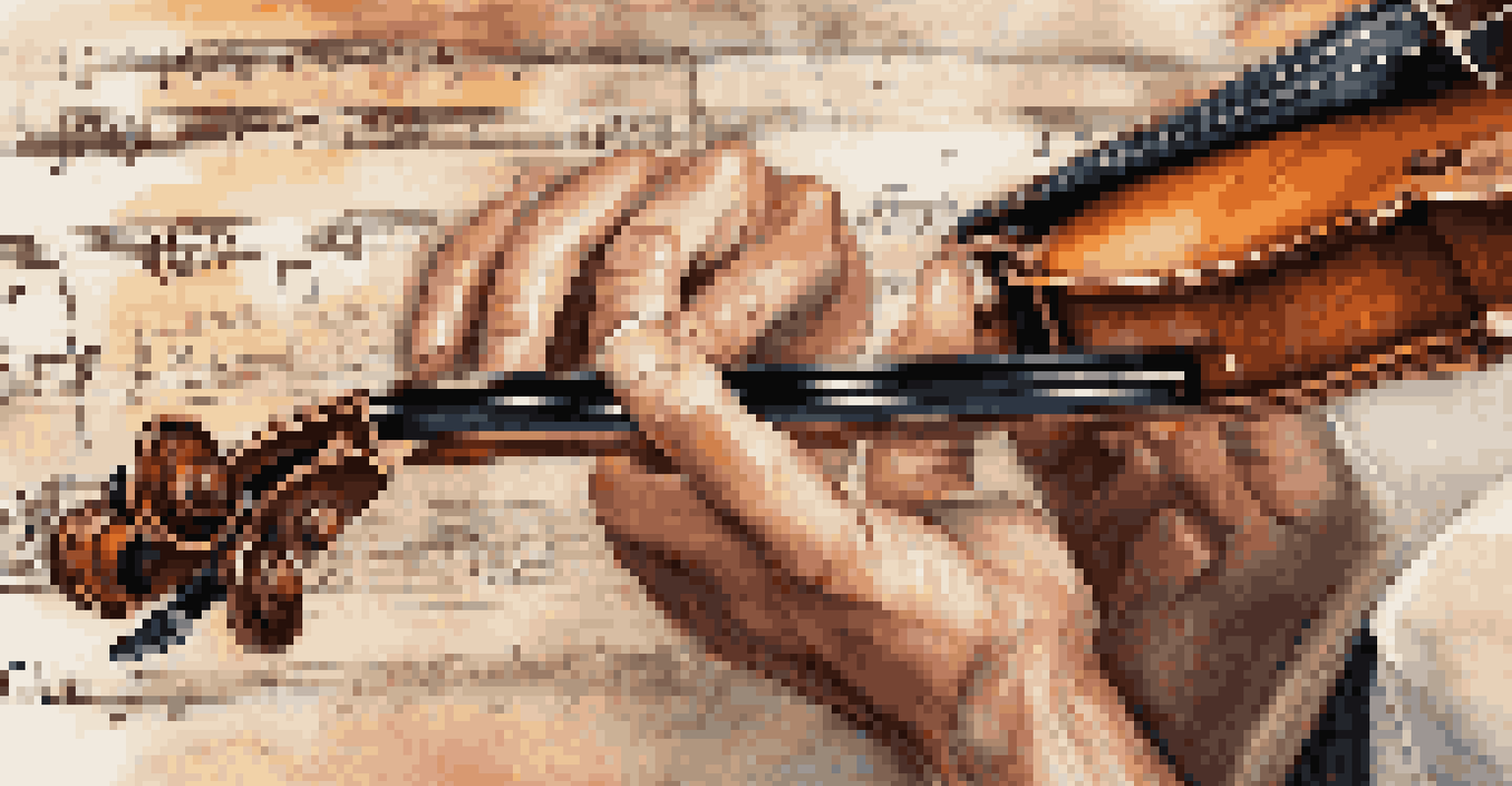Analyzing the Role of Arrangement in Music Evaluation

Understanding Musical Arrangement and Its Importance
Musical arrangement refers to the way different elements of a piece are organized, including instrumentation, harmony, and rhythm. It plays a crucial role in how a piece is perceived and enjoyed. Think of arrangement as the layout of a room; the way furniture is positioned can completely alter the atmosphere and functionality of the space.
Music is the shorthand of emotion.
Just as a well-arranged room invites guests to mingle, a thoughtfully arranged piece of music can captivate listeners, leading to deeper emotional connections. When the arrangement is done right, it highlights the strengths of each instrument and allows them to shine. This careful balancing act can transform a simple melody into a rich, textured experience.
In essence, arrangement is not just about aesthetics; it's about enhancing the listener's journey through the music. By manipulating elements like dynamics and timbre, arrangers can guide listeners through an emotional landscape, making them feel more invested in the music.
The Role of Arrangement in Different Genres
Different music genres utilize arrangement in unique ways, reflecting their distinct characteristics and cultural backgrounds. For instance, a classical symphony often features a diverse array of instruments, meticulously arranged to create a cohesive sound. Conversely, in pop music, arrangement may prioritize catchy hooks and repetitive structures to engage listeners quickly.

Take jazz, for example; the arrangement often leaves room for improvisation, allowing musicians to showcase their individuality within the framework of the piece. This flexibility creates a dynamic listening experience, where no two performances are ever the same. Understanding these nuances helps listeners appreciate the artistry involved in each genre's arrangement.
Arrangement Shapes Musical Experience
Musical arrangement is crucial as it influences how listeners perceive and engage with a piece, enhancing their emotional journey.
Ultimately, the genre informs how arrangements are crafted, influencing everything from song structure to instrumental choices. A well-executed arrangement can elevate a song, making it memorable and impactful, regardless of the genre.
How Arrangement Affects Listener Engagement
Listener engagement is vital for the success of any musical piece, and arrangement plays a significant role in fostering this connection. A well-structured arrangement can create peaks and valleys in the music, keeping the audience hooked from start to finish. This ebb and flow mirrors the natural rhythms of conversation, drawing listeners in and maintaining their interest.
Arrangement is the art of placing things in their most effective position.
For instance, consider a song that gradually builds in intensity before reaching a climactic moment. This strategic arrangement keeps listeners on the edge of their seats, eagerly anticipating the release of tension. When done effectively, it transforms a passive listening experience into an active emotional journey.
Furthermore, engaging arrangements often incorporate surprise elements, like unexpected key changes or shifts in tempo. These moments can evoke strong reactions, enhancing the listener's overall enjoyment and investment in the music.
Evaluating Music: The Role of Arrangement
When evaluating music, arrangement is a key factor that can make or break a piece. Critics and listeners alike often assess how effectively the arrangement contributes to the overall sound and message of the music. This evaluation goes beyond mere preference; it involves understanding how the arrangement shapes the listener's experience.
For example, an arrangement that feels cluttered or disorganized may detract from a song's emotional impact, leaving listeners confused rather than moved. Conversely, a well-crafted arrangement can enhance clarity and cohesion, allowing the music's core message to shine through. This is particularly important in genres where storytelling is paramount, such as folk or singer-songwriter music.
Genres Influence Arrangement Styles
Different music genres utilize unique arrangement techniques that reflect their cultural backgrounds and characteristics.
Ultimately, examining arrangement during music evaluation provides insight into the artistic choices made by composers and arrangers. It reveals how these choices influence the audience's perception and connection to the piece.
The Impact of Technology on Music Arrangement
In recent years, technology has revolutionized the way music is arranged, opening up new possibilities for creativity and experimentation. Digital audio workstations (DAWs) allow musicians to manipulate sounds and structures in ways that were once unimaginable. This accessibility encourages a broader range of artists to experiment with their arrangements, leading to innovative sounds and styles.
For example, artists can now layer multiple tracks, incorporate electronic elements, and seamlessly blend genres to create unique arrangements. This has led to a more diverse music landscape, where traditional boundaries are blurred. The ease of technology means that even budding musicians can create professional-quality arrangements from their homes.
However, while technology offers exciting opportunities, it also presents challenges. With so many options available, it can be easy to fall into the trap of over-complication, losing the essence of the music. Striking a balance between technological innovation and musical integrity is crucial for effective arrangement.
The Future of Musical Arrangement
As we look to the future, the field of musical arrangement continues to evolve. Emerging trends, such as the fusion of genres and the rise of artificial intelligence in music production, are reshaping how arrangements are approached. This evolution presents exciting opportunities for creativity and collaboration among artists.
For instance, AI tools can assist musicians in generating new ideas and arrangements, providing a fresh perspective on their work. While some may view this as a threat to traditional artistry, it can also be seen as a tool that enhances creativity. The collaboration between human intuition and machine efficiency may lead to groundbreaking arrangements that push the boundaries of music.
Technology Transforms Music Arrangement
Advancements in technology have revolutionized music arrangement, allowing for greater creativity while posing challenges in maintaining musical integrity.
Ultimately, the future of musical arrangement will likely be characterized by increased experimentation, diversity, and integration of technology. As artists continue to explore new frontiers, the role of arrangement will remain a vital aspect of the music-making process.
Conclusion: The Significance of Arrangement in Music
In conclusion, arrangement is a fundamental component of music evaluation and enjoyment. It influences how listeners perceive and engage with a piece, shaping their emotional responses and overall experience. By understanding the intricacies of arrangement, we can gain a deeper appreciation for the artistry involved in music creation.
Moreover, as technology and genres evolve, the role of arrangement will continue to adapt, presenting both challenges and opportunities for musicians. Recognizing the impact of arrangement on music can enrich our listening experience, allowing us to connect with the art on a more profound level.

Ultimately, whether you're a casual listener or an aspiring musician, appreciating the nuances of arrangement can enhance your understanding of music. It invites us to explore the layers of sound and emotion that each arrangement brings to life, making our musical journeys all the more fulfilling.